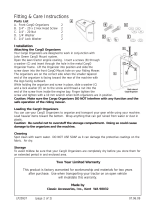
5
CroozerCargo14-ENG-2-14
Safety Guidelines
Safety Guidelines
Symbols and warnings
DANGER indicates a hazardous situation which, if not
avoided, will result in death or serious injury.
WARNING indicates a hazardous situation which, if not
avoided, could result in death or serious injury.
CAUTION indicates a hazardous situation which, if not
avoided, could result in minor or moderate injury.
NOTICE indicates a situation which, if not avoided, could
result in damage to the Croozer Cargo or the environ-
ment.
Tip: In this manual, “Tip” indicates helpful advice about
the use or maintenance of the Croozer Cargo.
Read and observe this manual!
This manual contains information that is extremely im-
portant for your safety and the safety of other road users.
Therefore, it is essential that you read the entire manual
carefully and follow the instructions closely. If you should
experience dif culties understanding any of the information
or instructions, please contact your Croozer dealer. Keep
this manual handy at all times for future reference. If you
loan or sell your Croozer Cargo, pass on this manual to
the new user. It is also vitally important that you read and
observe the instructions provided in the manual of the
towing bicycle.
Who can ride the towing bicycle?
Be sure to acquaint yourself with the applicable laws in the
state or country where you plan to use the Croozer Cargo.
Requirements for the towing bicycle
The towing bicycle must be approved by its manufacturer
for pulling a trailer. This information can be found in the
owner’s manual of the bicycle. Furthermore, the towing
bicycle must be in perfect working order and have strong,
properly functioning brakes. Motorised vehicles may not
be used for pulling Bicycle Trailers. The only exception to
this rule is a pedelec. This special type of e-bicycle has
an electric motor that delivers assist only when the rider
pedals. In many countries, pedelecs legally qualify as
bicycles. However, e-bikes with a maximum speed of more
than 12 mph (20 km/h) may not be used for pulling the
trailer. The towing bicycle should be equipped with a sturdy
rear-mount kickstand to ensure safety when loading and
unloading the Trailer.
Be sure to familiarise yourself with the legal requirements
that apply to towing bicycles in the country or state where
you will be using the Croozer Cargo.
The towing bicycle must have a 26” or 28” (559 or 622mm)
rear wheel. This information can be found on the tyre
sidewalls. The numbers 42-622, for example, indicate that
the tyre has a width of 42 mm and a bead-seat diameter of
622 mm (28 inches).
Legal requirements for using a Bicycle
Trailer
Be sure to familiarise yourself with the legal requirements
that apply to pulling a Bicycle Trailer in the country or state
where you will be using the Croozer Cargo.
Before your rst ride ...
It is vitally important that you familiarise yourself with the
Croozer Cargo before you use it for transporting cargo.
Prior to your rst ride with the Trailer on public roads, Zwei
plus zwei GmbH recommends taking a practice ride in a
calm, traf c-free area. This is a great way to acquaint your-
self with the handling of the bicycle and the dimensions of
the Trailer.
Crushing hazard
When folding and unfolding the Croozer Cargo, keep
ngers and hands clear of all possible pinch points (e.g.
movable frame parts and locking mechanisms).
Pulling the Croozer Cargo as a Bicycle
Trailer
Before each ride, check the following:
• Are the wheels securely attached?
• Are both vertical frame tubes snapped securely into the
clips?
• Are all security pins correctly inserted and locked?
Check that none of the security pins are hanging freely
from their straps.
• Check tyre pressure prior to each ride. The actual tyre
pressure should never be higher or lower than the
maximum and minimum in ation pressures marked on
the tyre sidewall. (See also page 24). Never use com-
pressed air, e.g. from a gas/petrol station, to ll your
tyres. The rapid air ow and high pressure can overin-
ate the tyres, causing the tube and/or tyre to burst.
Turning
Always reduce your speed to a walking pace when mak-
ing turns with the Bicycle Trailer. Keep in mind that riding
speed is often underestimated, especially on bikes with
electric assist. When turning at high speeds, the increased
centrifugal force can cause the trailer to skid or tip over
and result in accidents with serious injury or death.
Riding downhill
Always reduce your speed when riding downhill. Riding at
excessive speeds can cause the Trailer to skid, potentially
resulting in accidents with serious injury or death.
Riding over curbs or uneven surfaces
Riding over a curb or other obstacle with only one wheel
of the Bicycle Trailer could cause the trailer to tip over,
resulting in accidents with serious injury or death. Empty
trailers are especially susceptible to tipping. Therefore, if
you have to ride over a curb or similar obstruction, always
use extreme caution and ride at very low speeds. Never
use the Croozer Cargo on stairs or escalators.
Being visible to others
Never use your Croozer Cargo as a Bicycle Trailer in road
traf c without the safety ag mounted. The safety ag
makes it easier for other road users to see you.
































